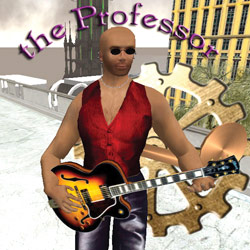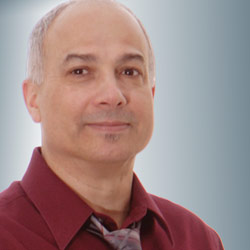
“At Imperial College London, medical students navigate a full-service hospital where they see patients, order X-rays, consult with colleagues and make diagnoses. It’s an interactive, hands-on learning experience—and none of it is real.” —CNN, March 30, 2009. “Can Second Life help teach doctors to treat patients?”
“With the recording industry in near-shambles and the recession taking a hit on art of all kinds, some musicians, visual artists and fashion designers have turned to another virtual frontier to sell CDs, earn tips, move paintings and grow international followings. —CNN, April 7, 2009. “Artists visit virtual Second Life for real-world cash”
These prospective doctors and real-life artists are interacting with one another in Second Life (SL), an online virtual world owned and operated by San Francisco-based Linden Lab. In this three-dimensional realm, users create alter-ego versions of themselves called avatars. More than one million people have signed up for the program since its 2003 launch.
The SL world is organized on a grid, with digital real estate—buildings, cities and islands—mapped to x, y and z coordinates. Avatars can enter these coordinates to “teleport” to the location of their choice. Everything “in-world” is built, coded and made to work by users, who can own real estate, mingle at virtual concerts and art shows, or hold meetings with business colleagues.
While Second Life is similar to today’s popular massively multiplayer online role-playing games, there are some key differences. SL doesn’t have levels, goals or rewards like traditional games. Instead, it provides unlimited creative freedom to its residents, allowing them to do just about anything, from going shopping or hanging out in a coffee shop to building a skyscraper or starting a business. Secondly, residents can pay a monthly lease to own virtual land, and they retain intellectual property rights over anything they create in-world.
Introducing Professor Beliveau
Professor Beliveau is the Second Life avatar of Edward Lamoureux, PhD, associate professor with Bradley University’s multimedia program and co-director of Bradley’s New Media Center. As Professor Beliveau, Lamoureux teaches “Field Research in Virtual Worlds” to his multimedia students.
Lamoureux’s specific areas of interest lie in field research and ethnography. “There are many different ways of describing it, but basically it’s a social-scientific research method used by anthropologists, sociologists, communication scientists and others to study the everyday lives of people in the field, in their places of community,” he explained. “It is a set of methodological practices, a series of ways of going into people’s lives and looking to see how they create and display the communities that they’re in.” With the rise of social networking and other virtual communities, the Internet has become one giant research lab for such work.
To truly understand a community, Lamoureux believes, one must observe it firsthand. “I’ve got to get out and be a participant/observer,” he declares. “I’ve got to watch you and see what happens, take notes, do interviews, find out what you actually do—and eventually, I will be able to say what your community is like.
“Alternatively, I could just send you a survey…but I wouldn’t get the same kind of understanding about social life that I’m interested in students having. Second Life is really good for that because there are lots of diverse communities, and it’s safe. It is absolutely unique in terms of how it works as a social environment.”
New Media at Bradley
Since 1996, Bradley University has been a member of the New Media Consortium (NMC), a community of hundreds of leading universities, museums and research centers. “[The NMC] produces an annual report to help us keep up with technology as it applies to teaching and learning,” said Lamoureux. In the early to mid-2000s, the NMC began to look at virtual worlds to determine which of the available options would be best for teaching and learning. They decided on Second Life.
In the summer of 2006, the NMC rolled out its virtual campus in SL and began to explain what one could do in it. His interest peaked, Lamoureux coordinated with Bradley to create a course in field research using Second Life, “not only as the subject, but as the workplace.” There were no traditional face-to-face classes—coursework was conducted entirely in the virtual world.
“Second Life presented an opportunity to keep up with my students in an online, massively multi-player environment,” said Lamoureux. “It’s a great place to teach field research because it’s a very global, diverse and interesting environment. It offers a lot of opportunities for students to learn how people construct, display and live in ‘communities of practice.’”
In addition to his role in the classroom, Lamoureux has performed music in Second Life since 2007 as “The Professor,” playing twice-weekly gigs at his SL home, Blacktail Ridge Retreat. While he had played in bands as a kid and sang folk music in college, he had since only played “here and there, now and then.” But a series of mysterious health problems and a nudge from his next-door neighbor in Second Life, a stained glass artist from Portland, pushed Lamoureux to explore the arts for its therapeutic value.
“We went to some live music [in Second Life], and she encouraged me to do this—to see what happens,” he recalled. So, after determining what it would take to sing and play in-world, he played his first SL gig on her land, and pretty soon it snowballed.
“I set up as if I was at any venue—guitar, amp, microphones—a standard setup. The microphones go into a mixer, which is connected to a computer that runs a streaming media service,” he explains. “The landowners in Second Life can set [their audio] to my stream, and I sing and play.”
A second computer hosts The Professor’s avatar. “I hired a guy to make a guitar that looks like the one I actually play,” said Lamoureux. “It came with animations so it looks like I am strumming, and another piece of software makes the avatar dance. So the avatar dances and strums and appears to be performing, while I am singing.” Meanwhile, audience members—usually 10 to 20 at a given gig—listen, dance and chat with others at the club.
In addition to performing music and teaching, Lamoureux paints watercolors, another activity he finds liberating and restorative. Since 2000, he has completed eight or nine paintings a year, and in February, the West of Ireland Art Gallery hosted an exhibit in Second Life featuring the watercolors and drawings of one Professor Beliveau.
Your Avatar is You
I did a bit of field research myself for this article. After installing the Second Life software, I became “Jonathan Umbarundu” and stumbled clumsily into one of The Professor’s gigs. I watched the show, danced for a bit and observed the 10 or 12 other avatars around me, with names like Professor Neox and Terran Timeless. It was very interesting, but my PC’s lack of sufficient memory and bandwidth made for a less-than-smooth experience—a key reason why virtual environments have yet to be adopted en masse.
Virtual reality (VR) technologies first made a splash in the 1990s, but their intrusive setup—with goggles, gloves, helmets and bulky, expensive hardware—left a lot to be desired. The vision of the VR community was just too far ahead of the available technology. “Maybe someday we’ll get to the point where you really do walk into a 3-D space that seems very real, but we’re still a ways off from that,” Lamoureux mused. “It would certainly be cool to walk down to your basement and play in Wrigley Field. But if it includes having to wear a lot of gear, it’s probably not going to diffuse into the whole culture.”
While there are those still working on Star Trek’s famous “holodeck,” designers of virtual worlds have learned that they don’t need to take over all of the senses to create a meaningful experience. “Our cognitive systems respond to media as if it’s real, even when it’s not,” explains Lamoureux. “I can make you jump out of your chair just watching a flat television across the room. You don’t have to be immersed in the media—you have to be immersed in the story.
“What we’ve come to find is that, if you give a certain representation of dimensionality, it’s enough that people will suspend disbelief, and it’s almost as if they were in virtual reality. So when you go into Second Life, it isn’t long before you start talking about your avatar as you. You won’t see many people in Second Life who say, ‘This is my avatar, John.’ They say, ‘Hi, I’m John.’”
Virtual worlds remain highly flawed, and businesses won’t find it very useful for traditional marketing purposes. Many companies that purchased virtual property to market real-world products have since pulled out. And yet there exist practical, real-world applications. Toyota, Coke and IBM have global operations, with employees from different cultures who don’t often come into contact with each other. All of them maintain a presence in Second Life.
“What they find,” says Lamoureux, “is that in a virtual environment, they can bring people together, break down a lot of those boundaries, and get people to have some fun. Then, when they bring them together in real life, they get along much better.”
Some businesses use Second Life as a low-cost teleconferencing program. Up to 40 people can watch videos, lay out plans, and work on projects together interactively. There are few comparable collaboration software packages available at that price.
Still others set up in virtual worlds to protect their brands and trademarks. “Gibson Music, for example, has an island,” says Lamoureux. “They’re not going to sell very many Gibson guitars [in SL]. They might sell a few, but I suspect that they are there to protect their brand in a virtual environment.” Such companies are anticipating the day when virtual worlds transition from the leading edge into our everyday lives.
There is little financial payoff for most users, but a handful of entrepreneurs make real money today on Second Life. SL has its own currency, called Linden dollars, which exchange at roughly 260 to the U.S. dollar. “It’s an interesting experiment in a micro-economy,” notes Lamoureux. It is estimated that about 1,000 people make over $1,000 a month on Second Life, while another 4,000 to 5,000 make at least $500 a month—in real money. And that doesn’t include the real-life companies subcontracted and paid by others to create software objects in-world.
Meanwhile, performers and artists, hard-hit by the global recession and decline of the music industry, are looking for alternative means of distributing their work and building an audience. Tough times often compel creativity, and Second Life may be a beneficiary of that notion. It’s impossible to predict the path of technology, but as the Internet becomes more sophisticated and wrapped around our daily lives, the idea of virtual worlds as a tool for learning, fellowship and collaboration becomes much more plausible. iBi


